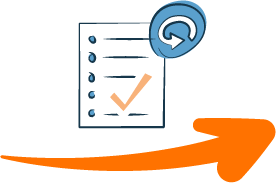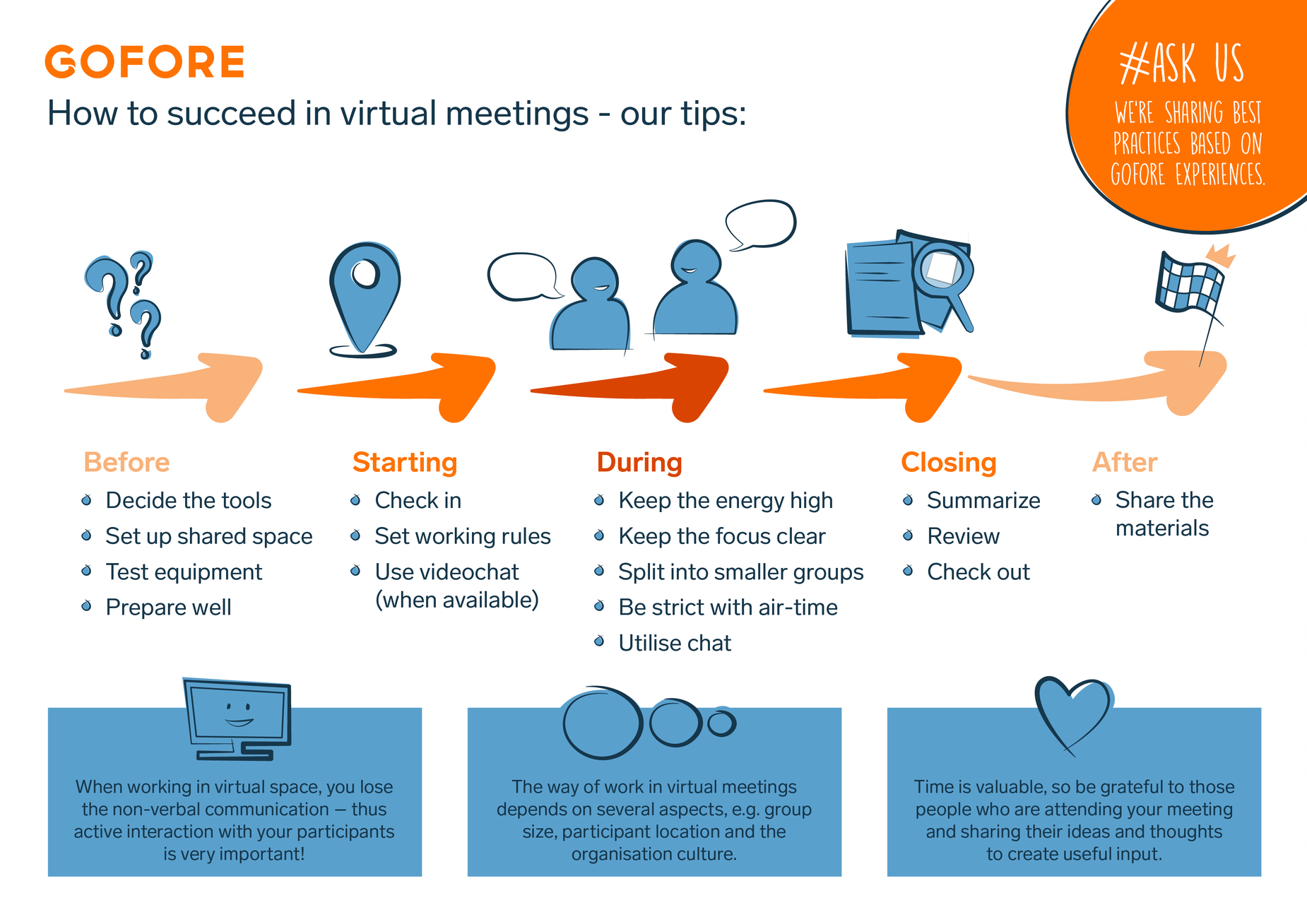Depending on your current organisational culture, the transformation from face-to-face meetings to virtual ones can be tricky. There are some aspects that you should consider before planning a virtual meeting, for example event purpose, targets, group size and locations, since they impact on how you should run your event.
There are some common practices that are easy to learn and apply to your to all your virtual meeting. To help you succeed in your digital encounters, we collected our best practices into five phases, following a common meeting flow: 1. Before, 2. Start, 3. During, 4. Close, 5. After.

Let’s go through each phase, one by one:

1. Before
Decide which tools you are going to use
When deciding which tool to use for a call, Microsoft Teams, Skype, Google Hangouts, Zoom and Slack are currently the most popular meeting tools. All have their pros and cons, but you’ll manage with each of them. If you want to participate people, you also need some kind of shared workspace. Some tools come with this already, like Skype for Business or Zoom, and some don’t. In those latter cases, you need to choose a separate tool for collaboration.
We recommend trying out these combinations:
- Teams /Zoom /Slack + Sharepoint Powerpoint /OneNote
- Google Hangouts + Jamboard /Docs /Pages
- Teams /Zoom + Mural /Miro (for more advanced workshopping)
Setup a shared space
- Make sure all your teammates have access to shared meeting files
- Prepare the materials you’re going to present and work on
Test the equipment
- If you’re able to use video stream, test your camera before the session starts
- If the participants are new to you, you have a big group of attendees or the meeting is going to be a lengthy one: start 10-15 minutes earlier to check that everything is working properly. You can also have a check-up session a day before the actual meeting – in that case the participants will have more time to fix their tools, if any problems occur.
- Remember to have a backup plan for those who have troubles joining the call, seeing the screen, using the collaboration tools etc. (Believe us, this happens quite often.)
There are a lot of things to consider, so always prepare well
- Make sure you have a clear agenda for the session.
- Flow: If the meeting includes workshopping, it’s best to timebox everything. Plan and walk through the whole agenda. If you haven’t organised remote meetings or workshops before, it’s good to rehearse with your colleagues beforehand.
- If the meeting includes ideation, it’s good to share background information about the ideation topic beforehand.
- Send information about the event beforehand to participants: agenda and system requirements. Encourage them to choose a good (quiet) location and ensure their tools are working. Give your participants also the possibility to get prepared.
- Consider recording the meeting, especially if some invitees can’t participate. Remember always to ask for recording consent, beforehand though!
- If you’re using a company meeting room for your meeting/workshop, it’s good to reserve the room 15 minutes before the event. You will need some time for getting organized.
- Consider having a co-host: If you’re workshopping with a large group, having someone helping you out with facilitating the event is useful. It decreases your organising pressure and usually shows in the participants’ satisfaction. While one host is presenting, the other one can concentrate on fixing possible practical challenges. Just remember to practice the choreography beforehand with your peer.

2. Start
Start with a check-in with all the participants
- Make sure everyone can hear each other. Say hello to every person individually, so they can reply out loud.
- Start your session by going through the purpose, target and the agenda for the meeting. Inform about the possible different phases that are included in the meeting (e.g. presentation, ideation, voting, discussions in pairs). Note: Unclarity breeds passiveness.
- Tell why you have invited these people in your meeting and tell about your expectations towards the participants
- Ask about expectations (utilise e.g. chat for this)
- Ask participants to inform in the beginning, if they need to leave early.
- Introduce people to each other (faster), or let them introduce themselves (takes more time)
- Use “ice-breakers”, to set a relaxed mood (ask us for details)
- Create a safe space for everyone to talk. Be an example.
Set working instructions
- Introduce roles, if there are any specific ones.
- Require focus: Phones should be put away. Microphone are supposed to be on mute if the person isn’t talking. Ask participants to close all other apps on their screen and focus solely on this meeting.
- Inform about possible breaks that you’re planning to have.
- Inform how to behave, if a participant needs to leave suddenly.
- Go through the tools and workshopping methods used.
- Set a protocol on how participants are allowed to speak (e.g. using icons, writing in chat, and starting with their name when they speak).
- Only one person should talk at a time, although there should not be long monologues.
Use video if possible
Video stream helps to engage and keep focus. However, it may also slow down the connection and cause other technical problems. Utilise video stream at least in the beginning of the session, to get more connected with your participants.

3. During
Keep the energy high
Following a long meeting or workshop remotely is tiring. Maintaining the focus can be hard for everyone.
Use your tools to engage and interact, to keep the energy levels high!
- If the meeting lasts more than 1.5 hours, have short breaks (remember to be very clear about the continuation time).
- Use “energizers”, if you feel that people are getting passive (ask us for details)
Keep the focus clear
- Keep the agenda visible, or at least easy to find (e.g. post it in the meeting chat, once everyone has arrived)
- Keep the current topic visible on screen to maintain focus.
- Write the meeting memo so that everyone can see it.
- Ensure action points are documented, reviewed, and have action owners.
Break up in small groups, if relevant
- If you’re ideating something, breaking up into smaller groups is a good idea. Some call tools enable this (like Zoom). Remember to give the groups clear instructions about the topic and the amount of time they’re allowed to use for it.
- “Me-We-Us” is a good method for ideating and problem solving (ask us for details)
- Working in smaller groups at times boosts energy within the team.
- Remember that dividing into small groups also requires some time, to get people oriented
- The smaller the groups, the less time they will need for working on tasks. Sometimes even 2 minutes can seem like a very long time.
Be strict with airtime
The great thing about remote meetings is that they can be more equal than live events for participants. Make sure same the people don’t dominate throughout the meeting and invite the silent ones to speak up their minds (you can try using a timer, for example).
Utilise the meeting chat
All call tools enable chat. For quickly collecting feedback, ask participants to write their thoughts in the meeting chat. Then allow few minutes for everybody to read the comments before proceeding.

4. Closing
Summarize and review
- Did you reach the target?
- What are the next action points?
- Do all action points have owners and deadlines?
Check-out
Ask feedback: Was the session useful for them? What felt important? What could be improved next time? Remember to thank everyone for their time and input!

5. After
Share the materials
Share the possible recording, workshop materials, meeting memos and action points to participants.
To summarize things up
Some things to remember:
#Virtual space relies heavily on sound and you lose a lot of the non-verbal communication. Thus, you need to pay more attention to interaction with participants. Read more about the topic here: How to have a great virtual meeting
#Thank people for attending your meeting. Time is valuable, and yet they have decided to use it in your event. Show that you appreciate their time, and they will be happy to join your next session!
Wish to get more tips?
We are happy to help you in facilitating your virtual meetings successfully. Please don’t hesitate to contact us at: jonna.iljin@gofore.com.
Sources:
https://gofore.com/en/how-to-have-a-great-virtual-meeting/
https://www.crisp.se/gratis-material-och-guider/remote-collaboration
Jonas Rajanto, Grape People, Basics of Virtual Facilitation



